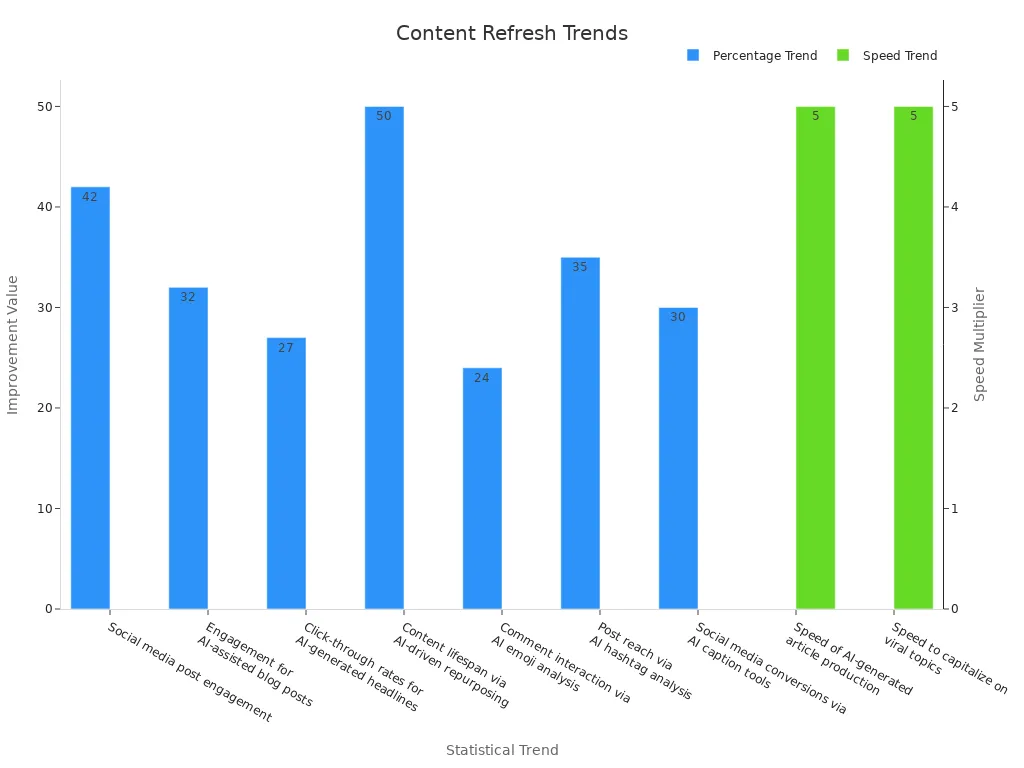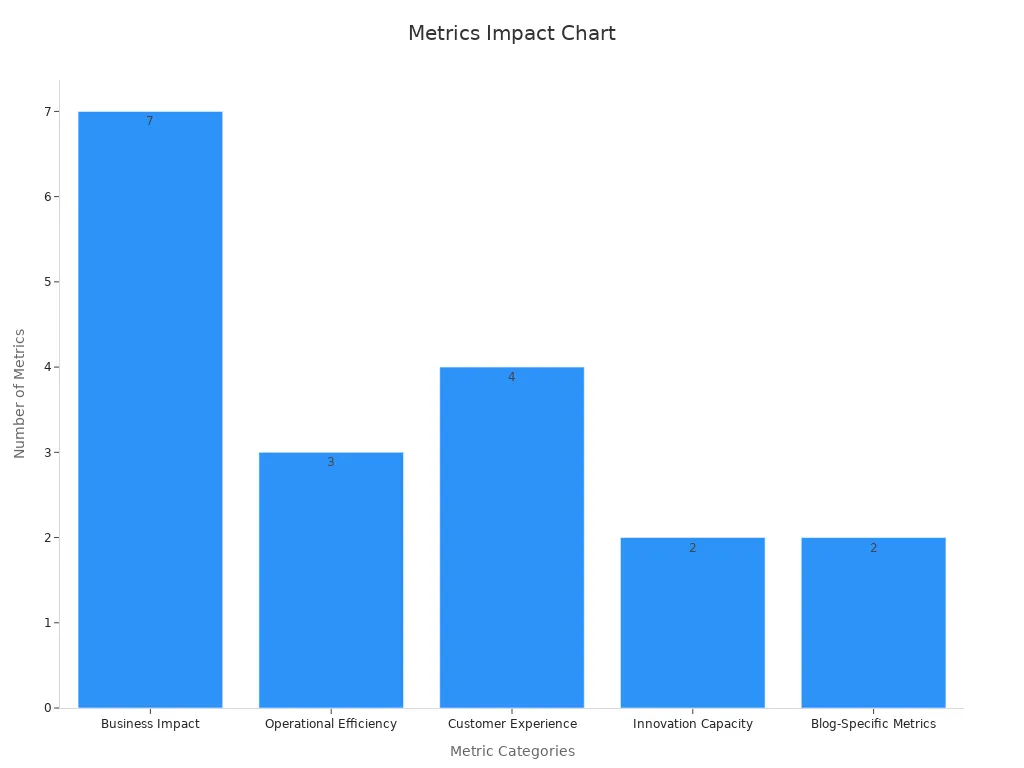Using AI to Prioritize Blog Refreshes

You know the feeling when your blog needs a boost, but you just don’t know where to start. Using ai can help you spot which posts need attention, so you don’t waste time guessing. With ai, you can improve quality, fix old mistakes, and keep readers coming back. Many bloggers see most of their organic traffic come from updated content, and adding new keywords or multimedia can lift your quality even more. Using ai means you refresh your blogs faster, see better engagement, and focus on what really matters—quality content that ranks.
Key Takeaways
AI tools help you quickly find which blog posts need updating by analyzing traffic, keywords, and outdated information.
Using AI automation saves time by fixing errors, updating content, and keeping your blog consistent and trustworthy.
Refreshing your blog with AI improves SEO rankings, boosts traffic, and keeps readers engaged with fresh, high-quality content.
AI helps you plan and schedule content updates smartly by predicting trends and audience behavior for better results.
Combining AI with human editing ensures your blog stays creative, accurate, and aligned with SEO best practices.
Using AI for Blog Refresh
Data Analysis
When you use ai to refresh your blog, you get a huge advantage. Ai tools can look at your blog’s performance in real time. They scan your posts, check which ones get the most traffic, and spot the ones that are falling behind. You don’t have to guess which blog needs a refresh. Ai blog writing platforms can show you which posts have outdated information or missing keywords. This makes your content stronger and keeps your readers happy.
Ai tools also help you see what your competitors are doing. You can compare your blog to others in your niche. Ai blog writing software checks for gaps in your content and finds topics you might have missed. This helps you stay ahead and keeps your blog fresh.
Tip: Ai-powered noise filtering removes junk data, so you only see what matters. This saves you time and helps you react faster to changes in your blog.
Ai models get smarter over time. They learn from your blog writing workflow and improve their accuracy. This means you get better suggestions for your next content refresh. Companies like Microsoft and Adobe have seen big jumps in user satisfaction after using ai to analyze and update their blogs. Ai-driven predictive analytics can even forecast what your readers will want next, so you can plan your blog updates before your traffic drops.
Here’s a quick look at how ai data analysis helps:
Benefit | What It Means for Your Blog |
|---|---|
Real-time insights | Spot outdated posts quickly |
Predictive analytics | Plan content before trends change |
Competitor analysis | Find new topics and stay ahead |
Improved accuracy | Fewer mistakes in your content |
Noise filtering | Focus on what matters, not junk data |
Automation Benefits
Using ai tools in your blog writing workflow saves you hours every week. Ai blog writing assistants can automate the content refresh process. They scan your blog for broken links, errors, and missing keywords. You get alerts when something needs fixing, so you never miss a chance to improve your blog.
Ai article rewriter tools can update old posts in minutes. You don’t have to rewrite everything by hand. These tools keep your tone and style consistent, so your blog always sounds like you. Ai-generated content can fill in gaps, add new facts, or rewrite sections that need a boost.
Ai-powered automation speeds up content creation. You can publish more blog posts without losing quality.
Ai tools help you scale your blog writing workflow. You can update many posts at once, not just one at a time.
Ai blog writing platforms check your content for accuracy and keep it up to date.
Ai-generated content can personalize your blog for different readers, making each visit feel special.
Note: Companies using ai automation have cut errors by over 60% and boosted productivity by up to 35%. Retailers like Zara now update their content in days instead of weeks.
Ai blog writing tools also help you follow your brand’s style guide. They make sure every post matches your voice. This is important for E-A-T (Expertise, Authoritativeness, Trustworthiness). Ai article rewriter tools can even help you rewrite posts to sound more expert or trustworthy.
If you want to keep your blog fresh and your readers engaged, using ai is the way to go. Ai writing assistant tools make the content refresh process simple, fast, and accurate. You get more done with less effort, and your blog stays ahead of the competition.
Why Refresh Content Matters
SEO Impact
You want your blog to show up at the top of search results, right? That’s where the real magic happens for your audience. When you refresh your blog content, you give it a better shot at climbing those rankings. Search engines love high-quality content that follows seo best practices. If you update your blog with new facts, fix old mistakes, and add missing keywords, you help your content stand out.
Let’s look at the numbers. Moving your blog from position 2 to position 1 in search results can boost your organic traffic by 50%. Even a small jump from position 7 to 6 can mean 20% more visitors. HubSpot found that 83% of marketers say refreshing content with a focus on quality works better than just pumping out lots of new posts. Over half of marketers saw improved search rankings when they kept publishing new material, but content refreshes made the biggest impact for blogs stuck between positions 4 and 20.
The first search result gets over 27% of clicks. If your blog sits lower, you miss out on a huge audience. Refreshing your content can push your blog higher, bringing in more readers and making your seo efforts pay off.
When you follow seo best practices and focus on content quality, you help your blog reach more people. High-quality content not only brings in traffic but also keeps your audience coming back for more.
User Engagement
You want your audience to stick around, read your blog, and take action. Updated content makes that happen. When you refresh your blog, you improve the experience for your audience. They find the answers they need, and they trust your blog more.
Data shows that blog posts usually have a conversion rate between 1-3%. If you add interactive content, you can double that rate. Mobile-friendly blogs keep 61% more visitors. Personalized calls-to-action work 42% better, and adding visuals can get you 94% more views. A/B testing your content can boost conversions by 14%. These changes show the real impact of high-quality content updates.
Here are some ways you can measure engagement after a content refresh:
Longer session times mean your audience finds your blog more interesting.
Lower bounce rates show your content keeps readers engaged.
Higher conversion rates prove your blog is helping your audience take action.
More social shares and referral traffic mean your content is reaching new people.
Tip: Use tools like Google Analytics to track how your audience interacts with your blog. Watch for changes in session time, bounce rate, and conversions after you update your content.
When you focus on content quality and follow seo best practices, you make a real impact on your audience. High-quality content keeps your blog fresh, boosts engagement, and helps you build a loyal audience.
Identify Posts to Refresh

Outdated Content
You want your blog to stay fresh and helpful. Outdated content can hurt your blog’s reputation and search rankings. Ai can help you spot old information fast. Ai tools scan your blog and look for dates in your sources, statistics, or news. If your blog mentions studies from years ago, ai will flag it for a refresh. Ai models know their own limits, too. For example, some ai tools only know facts up to a certain year, so they check if your content uses newer data.
Ai also checks your blog for broken links and missing keywords. If a link no longer works, ai will alert you. If your content misses important keywords, ai will suggest updates. This keeps your blog accurate and easy to find. Ai does not use fancy math to spot outdated content. Instead, it uses smart rules to check dates and sources. You save time and keep your blog up to date.
Tip: Set up regular ai scans to catch outdated content before your readers do.
Underperforming Posts
Not every blog post gets the attention it deserves. Ai helps you find which posts need a boost. Ai tools look at your blog’s traffic, engagement, and other key numbers. They show you which content has low clicks, high bounce rates, or slow load times. You can use these metrics to decide which posts to refresh first.
Here’s a quick table showing what ai checks:
Metric | Why It Matters |
|---|---|
Engagement Rates | Shows how much readers interact with your content. |
Page Views | Tells you how many people visit your blog. |
Bounce Rates | Shows if readers leave your blog too quickly. |
Click-Through Rates | Measures how often readers click your links. |
Conversion Tracking | Tracks if your blog helps you reach your goals. |
SEO Performance | Shows how well your content ranks in search engines. |
Retention Metrics | Checks if readers come back to your blog. |
Technical Metrics | Finds slow loading pages that may drive readers away. |
Ai can even compare your underperforming posts to your top content. You get clear ideas for improvement. Many companies see up to 59% more clicks and 45% more organic traffic after using ai to optimize their blog. Ai-driven refreshes can lift conversion rates by over 38%. With ai, you make smart choices and keep your blog growing.
Set Refresh Priorities with AI

Criteria Selection
You want your blog to stand out and reach your audience. Using ai helps you pick which posts to refresh first. You do not have to guess. Ai tools look at many things to help you make smart choices for your content strategy. They check if your blog posts match your topic, follow community standards, and show real value to your readers. Ai also checks if your content has the right citations and if the authors have strong backgrounds. This makes your blog more trustworthy and boosts your quality.
Here is a table that shows what ai looks for when you set your refresh priorities:
Criterion | Description |
|---|---|
Content relevance | Posts must align with a clear scope and purpose, ensuring focus and coherence consistent with their topic. |
Grant support details | Where applicable, acknowledgment of funding sources is recommended to validate support and credibility. |
Adherence to community standards | Compliance with recognized best practices and ethical guidelines ensures integrity and trustworthiness. |
Author distribution | Authors should represent diverse affiliations and have publication records validating their expertise. |
Appropriate citations | Posts must properly acknowledge relevant literature to situate content within the scholarly context. |
Editorial evaluation (impact) | Selection favors influential posts based on citation activity and impact within the field. |
Comparative citation analysis | Citation quantity, sources, and stability over time are considered to assess sustained influence. |
Author citation analysis | Authors’ publication and citation histories should align with the post’s category and scope. |
Editorial Board citation analysis | Editorial members’ citation networks should be relevant and demonstrate scholarly engagement. |
Content significance | Content should offer unique perspectives, regional focus, or enrich the breadth of coverage, adding value. |
When you use ai for your blogging strategy, you make sure your content meets the highest standards. This helps your audience trust your blog and keeps your quality high.
High-Potential Content
You want to get the most out of your content strategy. Ai can spot high-potential blog posts that will give you the best results after a refresh. These are the posts that can bring in more traffic, boost engagement, and help your audience find what they need. Using ai, you can see which posts have the best chance to go viral or get shared on social media.
Check out these trends that show how ai helps your blog grow:
Statistical Trend | Observed Improvement |
|---|---|
Social media post engagement | +42% |
Engagement for AI-assisted blog posts | +32% |
Speed of AI-generated article production | 5 times faster |
Click-through rates for AI-generated headlines | +27% |
Content lifespan via AI-driven repurposing | +50% |
Speed to capitalize on viral topics | 5 times faster |
Comment interaction via AI emoji analysis | +24% |
Post reach via AI hashtag analysis | +35% |
Social media conversions via AI caption tools | +30% |

When you use ai to refresh your blog, you work faster and smarter. Your content reaches more people, and your audience stays engaged. Ai makes your content strategy stronger and helps you get the most out of every blog post.
Build a Refresh Schedule
AI Recommendations
You want your blog to stay fresh and keep readers coming back. AI tools make this easy by giving you smart recommendations for your content calendar. These tools use real-time data and predictive analytics to help you decide when to update each post. You do not have to guess anymore. AI checks search trends, audience engagement, and even what your competitors are doing. It then suggests the best times to refresh your blog.
Here’s how AI tools help you build a winning schedule:
They monitor search trends and audience behavior to pick the right time for each refresh.
AI-powered content calendars look at your past blog performance and seasonal trends.
These tools balance your schedule so you never have too many or too few updates.
AI ranks your posts by search demand and engagement, so you know which ones to refresh first.
Predictive analytics show you when your readers are most active, helping you get the most out of every update.
AI tools also suggest when to repromote refreshed content for maximum reach.
Tip: Let AI tools handle the routine scheduling. You can focus on creating great content while AI keeps your calendar on track.
Action Plan
Now you need a simple plan to put these AI recommendations into action. Start by setting clear goals for your blog. Use AI tools to analyze your audience and decide how often you want to refresh your posts. Input your goals and audience data into your chosen tools. The AI will suggest the best days and times for updates.
Check out this table to see how using AI tools can boost your blog’s performance:
Metric | Before AI Implementation | After AI Implementation | Improvement (%) |
|---|---|---|---|
Average time per blog post | 8.5 hours | 3.2 hours | |
Monthly content production | 45-50 pieces | 115-120 pieces | ~150% increase |
Organic search visibility | — | — | 73% increase |
Engagement metrics | — | — | 28% improvement |
Content revision requests | — | — | 41% reduction |
AI tools help you keep your schedule consistent and your content relevant. They also remind you when it’s time to refresh or repromote refreshed content. This way, you never miss a chance to reach your audience. You can adjust your plan as you go, letting AI tools learn and improve your workflow. With this approach, you save time, publish more, and see better results.
Optimize Content with AI
Update Information
You want your blog to stand out with high-quality content. AI makes it easy to update your content and keep your blog fresh. When you use ai blog writing tools, you can scan your posts for old facts, broken links, or missing details. These tools help you spot what needs a refresh. You can add new stats, fix errors, and make sure your blog always gives readers the latest information.
Experts like Carolyn Shelby from Yoast say that ai changes how people find your blog. AI looks for clear, relevant, and high-quality content. If you update your content with ai, you can jump ahead of blogs that use old tricks. Research from Forrester shows that most buyers now use ai to find what they need. If your blog is easy for ai to read, you get more organic search traffic. You want your refreshed blog content to show up in these new search results.
Here are some ways ai helps you keep your blog up to date:
AI blog writing tools scan for outdated facts and suggest new sources.
AI-generated content can rewrite sections to match current trends.
AI checks your blog for broken links and missing keywords.
AI-powered content creation tools help you add tables, summaries, and clear headings.
Tip: Use ai to add a table of contents or a summary at the top of your blog. This helps both readers and ai systems find your best points fast.
Enhance SEO
You want your blog to rank higher and reach more people. AI makes seo optimization simple. With ai blog writing, you can find the best keywords and use them in your content. AI-generated content helps you match what people are searching for. These tools look at search trends, user behavior, and even what your competitors write about.
AI automates keyword research and content creation. You get high-quality content that matches seo best practices. Google’s ai systems, like RankBrain and BERT, use machine learning to understand what people want. If you use ai-generated content, your blog can answer questions better and show up higher in search results.
Check out what ai can do for your seo:
AI blog writing tools find high-value and long-tail keywords.
AI-generated content matches your blog to user intent.
AI-powered optimization tools improve your content structure and keyword placement.
AI-driven analytics help you spot trends and update your content before your traffic drops.
Note: 86% of seo professionals say ai helps them with keyword research and content optimization. AI makes it easier to follow seo best practices and keep your blog ahead of the curve.
When you use ai for content creation and optimization, you boost your blog’s quality and reach. High-quality content, updated with ai, keeps your readers happy and your blog growing.
Monitor and Adjust
Track Results
You want to know if your refreshed content is working. Tracking results helps you see what’s going well and what needs more attention. Start by setting a baseline before you use AI. This way, you can compare your blog’s performance before and after your updates. Look at numbers like page views, bounce rates, and how long people stay on your content. These numbers show if your content is getting better.
AI makes it easy to watch these metrics in real time. You can spot changes in organic click-through rates, especially now that Google AI Overviews take up more space in search results. Even if your content ranks first, you might see fewer clicks. Studies show a drop of about 2.23% in organic clicks, while AI Overviews grab almost 39% of clicks. That’s why you need to track user engagement and see how your content performs after every refresh.
Here’s a table to help you focus on the right metrics:
Metric Category | Metrics to Watch for Blog Refresh Impact |
|---|---|
Business Impact | Adoption rate, time savings, revenue growth, retention |
Operational Efficiency | Error rate, decision speed, process cycle time |
Customer Experience | Satisfaction scores, engagement, retention rate |
Innovation Capacity | New AI features, faster time-to-market |
Blog-Specific Metrics | Organic click-through rates, engagement, AI-driven search impact |
Tip: Use scorecards or dashboards to keep an eye on your content’s performance. This helps you react quickly and keep your content at top quality.

Refine Strategy
You want your content strategy to keep getting better. After you track your results, use what you learn to make smart changes. Watch for trends in your content’s page views, bounce rates, and click-through rates. If you see more people reading and sharing your content, you know your optimization is working. If not, it’s time to adjust.
Many marketers use AI to support their digital strategies. Over 60% rely on AI for better content optimization and keyword research. AI tools help you find what your audience wants and fill any gaps in your content. You can also use AI to check your content’s readability, topic depth, and how well it matches search intent. Real-time dashboards show you what’s working, so you can update your content fast.
Keep updating your content to stay relevant.
Use AI to personalize your content for different readers.
Mix editorial review with AI suggestions for the best quality.
Add technical SEO elements like meta tags for better optimization.
Note: Some brands have seen organic traffic grow by 52% in just three months after using AI for content optimization. AI helps you move from guessing to knowing what works, so your content keeps improving.
Tools and Tips for Refreshing Blogs
AI Tools
You have a lot of choices when it comes to ai tools for your blog writing workflow. ChatGPT, Jasper, Copy.ai, and Grammarly are some of the most popular options. These tools help you with content creation, proofreading, and even brainstorming new ideas. Using ai blog writing platforms, you can speed up your content strategy and keep your blog fresh. Many bloggers use an ai writing assistant to check for grammar, suggest keywords, and rewrite sections for better quality.
A recent trend shows that about 80% of bloggers and 70% of organizations now use ai tools for blog refreshes. Marketing, media, and tech industries lead the way, but you can benefit no matter your field. When you combine ai-generated content with human editing, you get the best results. Hybrid workflows boost traffic by 19%, improve conversion rates, and cut production time. You save money and get higher quality at the same time.
Here’s a quick table comparing different content creation methods:
Method | Traffic Change | Conversion Rate | Time per Item | SEO Ranking Improvement | Cost Reduction |
|---|---|---|---|---|---|
Human-only | +8% | 3.2% | 25 min | Baseline | Baseline |
Pure AI-generated | -11% | 1.9% | 2 min | -17% | -82% |
AI + Human Editing | +19% | 3.8% | 8 min | +24% | -54% |
Tip: Use ai tools as helpers, not replacements. Always review and personalize your refreshed blog content for the best quality.
Common Pitfalls
You might run into some problems when using ai for your blog. Over-automation is a big one. If you let ai tools do all the work, your blog can lose its personal touch and creativity. Ai-generated content sometimes misses the mark on emotional intelligence or user intent. It can also make mistakes with facts or mix up details, which hurts your quality and seo best practices.
Another pitfall is ignoring E-A-T (Expertise, Authoritativeness, Trustworthiness). Search engines want to see that your blog shows real knowledge and follows seo best practices. If you skip human editing, your content strategy can suffer. High resource costs and data issues can also slow you down.
Here are some ways to avoid these pitfalls:
Always use human editing with ai article rewriter tools.
Check your facts and sources for accuracy.
Use ai tools for research, proofreading, and templates, but add your own voice.
Keep your blog writing workflow flexible and review your content strategy often.
Note: The best results come from mixing ai blog writing with human creativity. This keeps your blog high-quality and helps you follow seo best practices.
When you refresh your blogs with ai tools, you boost quality and make your content stand out. Real stories show big jumps in website visits, organic traffic, and lower bounce rates when people use these tools. Check out the results:
Example | Results | Tools Used |
|---|---|---|
STACK Media | +61% visits, -73% bounce rate | BrightEdge, Intent Signal |
Randy Selzer | +80% organic traffic, 700+ keywords | WordLift Plugin |
Rocky Brands | +30% search revenue, +74% yearly growth | BrightEdge, Storybuilder |
You can use ai tools to spot content gaps, improve quality, and keep your blog fresh. Try these steps:
Audit your posts with ai tools for missing topics and low-performing pages.
Use tools to track bounce rates, keyword rankings, and backlinks.
Schedule regular updates to keep quality high.
Combine similar posts and add interactive tools for better user experience.
Keep using ai tools to refresh your blogs and watch your quality soar. Start your audit today and see how these tools help you grow.
FAQ
How often should you refresh your blog with AI?
You should check your blog every few months. AI tools can scan your posts and tell you when something needs an update. If you see traffic drop or new trends pop up, refresh sooner.
Can AI replace human writers for blog updates?
AI helps you work faster, but it cannot replace your voice. You still need to review and add your own ideas. The best results come when you mix AI suggestions with your personal touch.
What AI tool works best for beginners?
You can start with ChatGPT or Jasper. These tools have simple interfaces and helpful guides. They make it easy to scan, rewrite, and improve your blog posts.
Will using AI hurt your SEO?
No, AI can help your SEO if you use it right. Make sure you check facts and keep your content original. Google likes high-quality, helpful posts, so always review what AI creates.
See Also
Transforming Blogging With AI Tools That Redefine Content Creation
AI Blog Builders Simplify Hosting, Writing, And SEO Tasks
Proven Methods To Boost Blog SEO And Drive Traffic
Beginner’s Guide To Fast SEO Tips For Better Blog Rankings
Writesonic AI And QuickCreator Battle For Content Creation Supremacy

